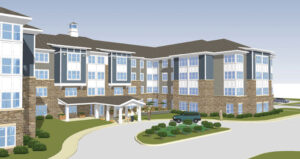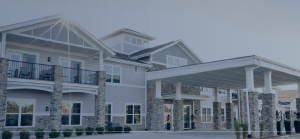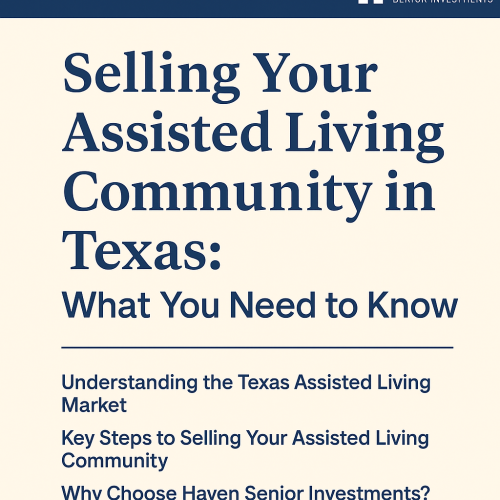What are the risks facing operators and financiers of seniors housing and care facilities?
Risk surrounds us. In our personal lives. In our professional lives. In our environment. In our regular day-to-day routines. Many of us try to minimize or at least mitigate risk to simply carry on. Otherwise, we could be caught frozen. However, every once in a while, it’s important to look around and acknowledge the risks in our lives to best prepare for unforeseen circumstances. This article looks at risks facing operators and financiers of seniors housing and care facilities. It is broken up into sections—those risks that are broad-based and apply to commercial real estate in general, and those that are more specific to seniors housing and care, separated into risks that are cyclical and those that are on-going. While not comprehensive, it provides a starting list of considerations.
Broad-based risks applicable to commercial real estate.
Economic risk. In August, the duration of the U.S. economic recovery reached 111 months, exceeding the 106-month expansion of the 1960s, although still falling short of the record 120-month job growth period enjoyed in the 1990s. Now, an economic cycle doesn’t end simply because it is lengthy, but economists are increasingly becoming concerned about the effects of tariffs on economic growth and stability, the impact of reduced fiscal stimulus from the tax cuts and spending plans in 2019 and beyond, and a broader global economic slowdown. As business leaders plan, it is important to keep in mind that a slowing economy is a risk to projected NOI expectations.
Interest rate risk. The cost of capital is going up. The July jobs report, as well as indications that GDP growth was strong in the second quarter, will provide further support for the Federal Reserve’s interest rates increases through 2018. As widely expected, the Fed increased the fed funds rate by 25 basis points at its June FOMC meeting, the second increase in 2018. The Fed has raised rates by a quarter percentage point seven times since late 2015, and most recently to a range between 1.75 percent and 2.00 percent, after keeping them near zero for seven years. The Fed’s June projections now show a total of four increases in the fed funds rate anticipated in 2018 (two of which have already occurred), up from an earlier expectation of three. Further increases are anticipated in 2019. Their projection for the fed funds rate in 2020 is 3.4 percent.
Inflation risk. While seemingly benign for years, there is a risk that inflation will start to accelerate. Tariffs on U.S. imports will directly push U.S. prices higher than what would have otherwise been expected. Additionally, wage rates and labor costs will begin to put upward pressure on wage inflation. Over the past 12 months, average hourly earnings have increased by 72 cents, or 2.7 percent. This is up from 2.5 percent on average in 2017. Workers are more confident and willing to quit because the economy and the labor markets are strong. Workers who quit experienced a nearly 30 percent larger pay increase in May than those who remained in the same job over the past 12 months, according to research by the Federal Reserve Bank of Atlanta.
Seniors housing-specific cyclical risks
Supply risk. At 87.9 percent in the second quarter of 2018, the occupancy rate for seniors housing fell to its lowest level in seven years, while the occupancy level for assisted living slipped back to its lowest level since NIC began reporting the data in 2006 (85.2 percent). The decline stems from new supply exceeding net absorption. While not the case in all markets, 17 of the 31 NIC MAP® primary markets had occupancy rates lower than year-earlier rates, as new demand simply could not keep pace with product deliveries. Taken together, these data points suggest that operators in many markets will need to pay careful attention to heightened competition and the effects it is having on rate growth and occupancy levels.
Employee risk. In today’s tight labor market environment, recruiting, training and retaining employees is more challenging than ever. The executive director (ED) or administrator of a property is critical to successful, profitable operations and sets the tone for an entire property, for both residents and staff. However, recruiting, hiring and retaining a strong ED may sometimes be a challenge. Successful operators manage this risk by financially incentivizing an ED who can build a strong team of employees that have service-oriented personalities and enjoy working directly with residents in an intimate relationship. More broadly, staff turnover can be reduced by establishing incentive programs and offering education and healthcare benefits to reward reliable attendance and longevity.
On-going seniors housing-specific risks
Resident turnover risk. Seniors housing resident turnover rates average between 37 percent and 56 percent annually, with assisted living/Alzheimer’s turnover at 56 percent and independent living turnover lower at 37 percent. Continuing care retirement communities (CCRCs), which attract residents based on the lifetime care model, have the lowest turnover at 22 percent. Turnover can be partly mitigated by integrating some clinical services on-site and may lengthen the stay of some residents. Best-in-class operators maintain a strong pipeline of new residents to fill vacated units.
Operator risk. As is often discussed, the operator is key in the financial success of a seniors housing property. Financiers of seniors housing properties need to work with an operator dedicated to serving the needs and desires of their residents in a manner that provides profits to ownership. Operators must have strong systems, policies and procedures that ensure resident safety and compliance with laws, while simultaneously creating a warm and caring environment that is appealing to their customers.
Increases in acuity. On average, seniors are older and frailer than they were in the past. The higher average age and greater frailty of residents affects length of stay, turnover rates, occupancy and, ultimately, operating income. These factors also affect staffing as residents need more help with activities of daily living, medication management and more personalized care. Higher turnover results in more vacant supply and the need for a more robust pipeline and marketing effort. Circumstances such as these require operator flexibility and the ability to adjust staffing accordingly. The operator must also be able to reassess residents and modify care charges in response to changes in acuity levels, if the operation is to remain profitable.
Technology risk. Technological innovation is emerging as a great influencer in seniors housing. From an operations perspective, lead generation is being delivered over the internet. In addition, IT systems and big data are allowing senior management to observe real-time changes in their day-to-day performance and operating systems, and remote monitoring of residents is generating staff efficiencies. From a health and wellness perspective, tele-health and virtual care systems have the potential to reduce health care costs and improve health care coverage by allowing instant video conferencing at call centers with live doctors. Smartphones and appliances, remote sensors, hand-held devices with medical applications, and mobile personalized connectivity applications and software systems have the potential to better allow aging in place, independence and virtual socialization. As these technologies get tested and winners and losers emerge, the operations, real estate and social and medical aspects of the sector will be forever changed. Hence, technology could pose a risk (which may be an opportunity, as well) to today’s understanding and perceptions of seniors housing property investments.
Other risks. There are other risks that investors should pay attention to. They are as follows: liability, insurance, reimbursement and regulatory changes. A lengthier discussion of the risks, as well as the opportunities associated with investing in seniors housing and care, can be found in the upcoming fifth edition of the NIC Investment Guide, to be released at the NIC Fall Conference in October 2018. To reserve a copy: http://info.nic.org/2018-investment-guide.
Written by:
Mace serves as chief economist and director of outreach with the National Investment Center for Seniors Housing and Care (NIC).






